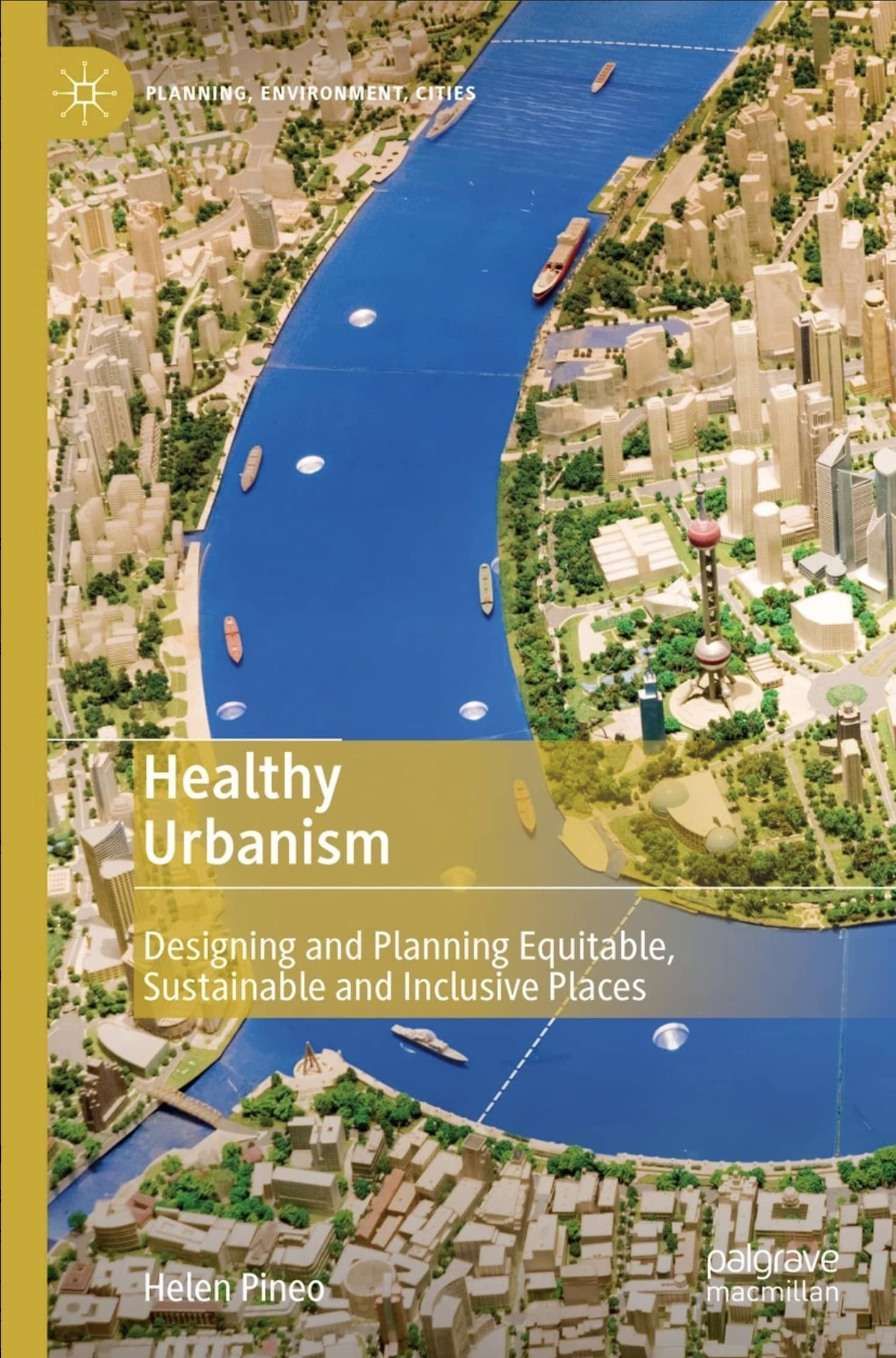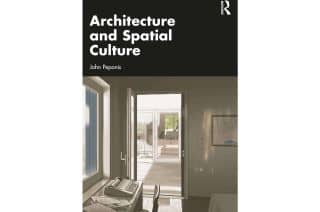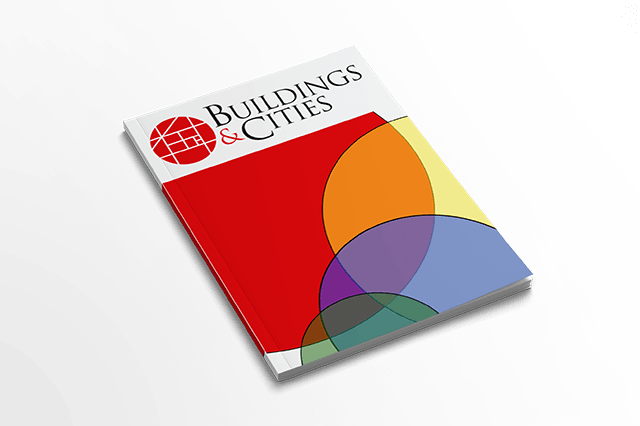
www.buildingsandcities.org/insights/reviews/healthy-urbanism.html
Healthy Urbanism. Designing and Planning Equitable, Sustainable and Inclusive Places
By Helen Pineo. Palgrave Macmillan, 2022, ISBN: 978-981-16-9646-6
Bomin Kim reviews this excellent book that provides a comprehensive and actionable guide to create equitable, inclusive and sustainable urban environments. The book is accessible to a wide audience and a must read for those seeking to deliver healthy urbanism worldwide through practice, activism and education.
Central to the book is the THRIVES framework (Towards Healthy uRbanism: InclusiVe, Equitable, Sustainable), an interdisciplinary framework that combines theories from social epidemiology, sustainable development, and systems thinking, developed through the author's extensive research and professional experience. The THRIVES framework illustrates health at three levels (local, ecosystem and planetary) across five geographical areas (region, city, district, neighbourhood and building), and outlines actions to improve the urban realm grounded in sustainability, inclusivity and equitability. The approach proposed shifts the focus from individual behaviours and genetic predispositions in health outcomes to addressing structural factors that influence health. By emphasising equity, inclusion and sustainability, the book provides a comprehensive perspective on urban planning and development that assists practitioners in exploring how urban environments impact health at different levels, with specific design and planning goals to consider. Supported by case studies from various global contexts, this approach enriches the narrative and makes the book a valuable tool for those involved in urban planning and public health.
The book is structured around nine chapters that build from understanding global urban health challenges to exploring actionable solutions. Pineo begins by delving into the social and physical determinants of health, using a systems thinking framework to address complex urban issues. Traditionally, health challenges associated with urbanisation have focused on communicable diseases, but Pineo broadens this to include modern urban health challenges exacerbated by extreme weather, social isolation, and long-standing inequities in community design and resource distribution. The book's detailed case studies and site-specific examples bring the research to life, making it accessible to readers both within and outside the fields of public health and urban design.
The first chapter introduces key concepts and definitions in urban health, establishing a foundation for the THRIVES framework through ecological health models that consider the built environment and its impacts on health as interconnected and dynamic factors, rather than in isolation. Chapter 2 reviews various approaches to healthy and sustainable urbanism, covering historical and contemporary initiatives by international organisations. Chapter 3 further delves into the THRIVES framework, providing an overview of its underpinning theory and concepts, including systems thinking, eco-social epidemiology, and 'just sustainability' that outlines planning processes that ensure residents' needs, perspectives and involvement. Combined with an introduction to epidemiology, the book gives readers a foundational understanding of the evidence linking health and the built environment, reemphasising how urban systems are dynamic with feedback loops that can either reinforce positive changes or exacerbate negative ones, thus requiring a comprehensive health approach that centres on sustainability, inclusivity and equitability.
Chapters 4 through 7 move sequentially through the framework's three scales of health impact: planetary, ecosystem and local health. Chapter 4 discusses design and planning measures to enhance biodiversity, resource efficiency and zero-carbon systems. Chapter 5 focuses on infrastructural systems ranging from air, water, soil, sanitation, waste and mobility infrastructure. Chapter 6 addresses local health at the neighbourhood scale, such as resource accessibility, culture, public space, food and safety. Chapter 7 explores building-scale issues such as acoustic and thermal comfort, housing affordability, lighting and space. Each chapter provides indicators that can be used to evaluate impact, demonstrating how design and planning goals are interconnected across the five geographic scales.
Chapter 8 focuses on implementing the principles of healthy urbanism in urban policymaking and design. Policy processes and development models are described along with insights for overcoming common barriers to healthy urbanism, including development economics. The last chapter discusses healthy built environment strategies for disaster preparedness and prevention, crucial for future pandemics and extreme weather events. The book also emphasises the need to frame health topics for broader audiences and how complex problems around health, environment and climate change need to be communicated. In a time where reactions to climate change range from climate doomism to denialism, experts need to consider how people process information and the narratives they adopt. Given the scale and urgency of urban health challenges, a solution-focused approach ranging in scale and impact is recommended. Although consideration is devoted to the potential impact of technological innovations and large-scale top-down transdisciplinary solutions, it is noted that smaller projects have the potential for significant impact through greater societal awareness that can shift political agendas.
The case studies underscore how healthy spaces have been integral to city-building for millennia. A variety of cities, capturing both Eastern and Western perspectives is drawn upon. It is argued that while technocratic and engineered climate solutions are popular and prevalent, traditional and vernacular solutions to complex urban problems should not be undervalued. This historical perspective enriches the framework, acknowledging the value of time-tested practices alongside modern innovations. The narrative emphasises that creating an inclusive, equitable and sustainable city is context-dependent, highlighting that there is no single typology or solution to achieving healthy urbanism. This enhances the book's applicability and relevance to a global audience.
This book contributes to current knowledge and research by reframing urban health through the THRIVES framework. The holistic approach emphasises the interconnectedness of inter-scalar sustainability, equity and inclusion. Although the case studies from various global contexts enrich the narrative, the solutions at times seem more aspirational than practical given the broader systemic issues that prevent large-scale interventions and operationalising initiatives in different cities. Nevertheless, the framework and narrative make it an excellent starting point both for readers new to the subject and for professionals and practitioners who wish to design healthier urban environments.
Researchers will find this book offers a robust theoretical foundation and examples that can guide future research in urban health and sustainability. The THRIVES framework can be used to explore the complex interactions between urban environments and health outcomes across numerous design disciplines and contexts. For policymakers, the book serves as a comprehensive guide to developing policies that promote healthy urbanism. The THRIVES framework can help create regulations ensuring urban spaces that enhance health and well-being. The book is also accessible to the general public, raising awareness about the importance of multi-scalar healthy urban environments.
Pineo's Healthy Urbanism is a great resource for anyone involved in urban planning, public health or community development. It provides a thorough and actionable guide to creating urban environments that promote health, equity and sustainability. By adopting the principles outlined in the book, stakeholders can contribute to developing healthier, more inclusive and resilient cities. The book offers hope and optimism at a time when urban problems can seem too complex and untenable. Its practical strategies provide a valuable addition to the growing body of literature on sustainable urbanism, offering readers not only theoretical insights but also real-world applications. The emphasis on inclusivity, equitability and sustainability ensures that this book is relevant to a wide audience, from policymakers to practitioners to the general public, making it an essential read for those committed to fostering healthier urban environments and to the field of sustainable urbanism.
Latest Peer-Reviewed Journal Content
A framework for 1.5°C-aligned GHG budgets in architecture
G Betti, I Spaar, D Bachmann, A Jerosch-Herold, E Kühner, R Yang, K Avhad & S Sinning
Net zero retrofit of the building stock [editorial]
D Godoy-Shimizu & P Steadman
Co-learning in living labs: nurturing civic agency and resilience
A Belfield
The importance of multi-roles and code-switching in living labs
H Noller & A Tarik
Researchers’ shifting roles in living labs for knowledge co-production
C-C Dobre & G Faldi
Increasing civic resilience in urban living labs: city authorities’ roles
E Alatalo, M Laine & M Kyrönviita
Co-curation as civic practice in community engagement
Z Li, M Sunikka-Blank, R Purohit & F Samuel
Preserving buildings: emission reductions from circular economy strategies in Austria
N Alaux, V Kulmer, J Vogel & A Passer
Urban living labs: relationality between institutions and local circularity
P Palo, M Adelfio, J Lundin & E Brandão
Living labs: epistemic modelling, temporariness and land value
J Clossick, T Khonsari & U Steven
Co-creating interventions to prevent mosquito-borne disease transmission in hospitals
O Sloan Wood, E Lupenza, D M Agnello, J B Knudsen, M Msellem, K L Schiøler & F Saleh
Circularity at the neighbourhood scale: co-creative living lab lessons
J Honsa, A Versele, T Van de Kerckhove & C Piccardo
Positive energy districts and energy communities: how living labs create value
E Malakhatka, O Shafqat, A Sandoff & L Thuvander
Built environment governance and professionalism: the end of laissez-faire (again)
S Foxell
Co-creating justice in housing energy transitions through energy living labs
D Ricci, C Leiwakabessy, S van Wieringen, P de Koning & T Konstantinou
HVAC characterisation of existing Canadian buildings for decarbonisation retrofit identification
J Adebisi & J J McArthur
Simulation and the building performance gap [editorial]
M Donn
Developing criteria for effective building-sector commitments in nationally determined contributions
P Graham, K McFarlane & M Taheri
Reimagining circularity: actions for optimising the use of existing buildings
R Lundgren, R Kyrö, S Toivonen & L Tähtinen
Effective interdisciplinary stakeholder engagement in net zero building design
S Vakeva-Baird, F Tahmasebi, JJ Williams & D Mumovic
Metrics for building component disassembly potential: a practical framework
H Järvelä, A Lehto, T Pirilä & M Kuittinen
The unfitness of dwellings: why spatial and conceptual boundaries matter
E Nisonen, D Milián Bernal & S Pelsmakers
Environmental variables and air quality: implications for planning and public health
H Itzhak-Ben-Shalom, T Saroglou, V Multanen, A Vanunu, A Karnieli, D Katoshevski, N Davidovitch & I A Meir
Exploring diverse drivers behind hybrid heating solutions
S Kilpeläinen, S Pelsmakers, R Castaño-Rosa & M-S Miettinen
Urban rooms and the expanded ecology of urban living labs
E Akbil & C Butterworth
Living with extreme heat: perceptions and experiences
L King & C Demski
A systemic decision-making model for energy retrofits
C Schünemann, M Dshemuchadse & S Scherbaum
Modelling site-specific outdoor temperature for buildings in urban environments
K Cebrat, J Narożny, M Baborska-Narożny & M Smektała
Understanding shading through home-use experience, measurement and modelling
M Baborska-Narożny, K Bandurski, & M Grudzińska
Building performance simulation for sensemaking in architectural pedagogy
M Bohm
Beyond the building: governance challenges in social housing retrofit
H Charles
Heat stress in social housing districts: tree cover–built form interaction
C Lopez-Ordoñez, E Garcia-Nevado, H Coch & M Morganti
An observational analysis of shade-related pedestrian activity
M Levenson, D Pearlmutter & O Aleksandrowicz
Learning to sail a building: a people-first approach to retrofit
B Bordass, R Pender, K Steele & A Graham
Market transformations: gas conversion as a blueprint for net zero retrofit
A Gillich
Resistance against zero-emission neighbourhood infrastructuring: key lessons from Norway
T Berker & R Woods
Megatrends and weak signals shaping future real estate
S Toivonen
A strategic niche management framework to scale deep energy retrofits
T H King & M Jemtrud
Generative AI: reconfiguring supervision and doctoral research
P Boyd & D Harding
Exploring interactions between shading and view using visual difference prediction
S Wasilewski & M Andersen
How urban green infrastructure contributes to carbon neutrality [briefing note]
R Hautamäki, L Kulmala, M Ariluoma & L Järvi
Implementing and operating net zero buildings in South Africa
R Terblanche, C May & J Steward
Quantifying inter-dwelling air exchanges during fan pressurisation tests
D Glew, F Thomas, D Miles-Shenton & J Parker
Western Asian and Northern African residential building stocks: archetype analysis
S Akin, A Eghbali, C Nwagwu & E Hertwich
Join Our Community

The most important part of any journal is our people – readers, authors, reviewers, editorial board members and editors. You are cordially invited to join our community by joining our mailing list. We send out occasional emails about the journal – calls for papers, special issues, events and more.
We will not share your email with third parties. Read more



Latest Commentaries
COP30 Report
Matti Kuittinen (Aalto University) reflects on his experience of attending the 2025 UN Conference of the Parties in Belém, Brazil. The roadmaps and commitments failed to deliver the objectives of the 2025 Paris Agreement. However, 2 countries - Japan and Senegal - announced they are creating roadmaps to decarbonise their buildings. An international group of government ministers put housing on the agenda - specifying the need for reduced carbon and energy use along with affordability, quality and climate resilience.
Building-Related Research: New Context, New Challenges
Raymond J. Cole (University of British Columbia) reflects on the key challenges raised in the 34 commissioned essays for Buildings & Cities 5th anniversary. Not only are key research issues identified, but the consequences of changing contexts for conducting research and tailoring its influence on society are highlighted as key areas of action.